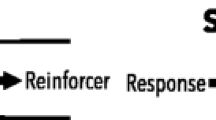Abstract
Gestalt imagery—the ability to create imaged wholes—is a critical factor in oral and written language comprehension. Despite good decoding, good vocabulary, and adequate background experiences, many individuals experience weak gestalt imagery, thus processing “parts” rather than “wholes,” from verbal stimuli, spoken or written. This contributes to a Language Comprehension Disorder that may be accompanied by a commonality of symptoms: weak reading comprehension, weak oral language comprehension, weak oral language expression, weak written language expression, difficulty following directions, and a weak sense of humor. Sequential stimulation using an inquiry technique develops gestalt imagery and results in significant improvement in reading comprehension.
Similar content being viewed by others
References
Aristotle. 1972.Aristotle on Memory. Providence, Rhode Island: Brown University Press.
Arnheim, R. 1966. Image and thought.In G. Kepes (ed.).Sign, Image, Symbol. New York: George Braziller, Inc.
Bell, N. 1986.Visualizing and Verbalizing for Language Comprehension and Thinking. Paso Robles, California: Academy of Reading Publications.
Bleasdale, F. 1983. Paivio’s Dual-Coding Model of Meaning Revisited.In J. C. Yuille (ed.).Imagery, Memory and Cognition: Essays in honor of Allan Paivio. New Jersey: Lawrence Erlbaum Associates.
Bower, G. H. and Morrow, D. G. 1990. Mental models in narrative comprehension.Science: Jan: 44–48.
Kosslyn, S. M. 1976. Using imagery to retrieve semantic information: A developmental study.Child Development 47:434–444.
Kosslyn, S. M. 1983.Ghosts in the Minds Machine. New York: W. W. Norton.
Levin, J. R. 1973. Inducing comprehension in poor readers.Journal of Educational Psychology 65:19–24.
Levin, J. R. 1981. On functions of pictures in prose.In F. Pirozzolo and M. Wittrock (eds.).Neuropsychological and Cognitive Processes in Reading. New York: Academic Press.
Linden, M. A. and Wittrock, M. C. 1981. The teaching of reading comprehension according to the model of generative learning.Reading Research Quarterly 17:44–57.
Long, S. A., and Winograd, P. N., and Bridge, C. A. 1989. The effects of reader and text characteristics on reports of imagery during and after reading.Reading Research Quarterly 19(3):353–372.
Marks, D. F. 1972. Vividness of visual imagery and effect on function.In P. Sheehan (ed.).The Function and Nature of Imagery. New York: Academic Press.
Oliver, M. E. 1982. Improving comprehension with mental imagery. Paper read at the Annual Meeting of the Washington Organization for Reading Development of the International Reading Association, Seattle, Washington, March 1982.
Paivio, A. 1969. Mental imagery in associative learning and memory.Psychological Review 76:241–263.
Paivio, A. 1971.Imagery and Verbal Processes. New York: Holt, Rinehart, and Winston. Reprinted 1979. Hillsdale NJ: Lawrence Erlbaum Associates.
Paivio, A. 1986.Mental Representations: A dual coding approach. New York: Oxford University Press.
Peters, E. E. and Levin, J. R. 1986. Effects of a mnemonic imagery strategy on good and poor readers’ prose recall.Reading Research Quarterly 21:179–192.
Piaget, J. and Inhelder, B. 1971.Imagery and the Child. New York: Basic Books, Inc.
Pirozzolo, F. and Wittrock, M. 1981.Neuropsychological and Cognitive Processes in Reading. New York: Academic Press, Inc.
Pressley, G. M. 1976. Mental imagery helps eight-year-olds remember what they read.Journal of Educational Psychology 68: 355–359.
Pribram, K. 1971.Languages of the Brain: Experimental paradoxes and principles in neuropsychology. New York: Brandon House, Inc.
Richardson, A. 1969.Mental Imagery. London: Routledge and Kegan Paul.
Rollins, M. 1989.Mental Imagery: On the limits of cognitive science. New Haven, Connecticut: Yale University Press.
Sadoski, M. 1983. An exploratory study of the relationship between reported imagery and the comprehension and recall of a story.Reading Research Quarterly 19(1):110–123.
Sheehan, P. W. (ed.). 1972.The Function and Nature of Imagery. New York: Academic Press.
Smith, B. D., Stahl, N., and Neil, J. 1987. The effect of imagery instruction on vocabulary development.Journal of College Reading and Learning 20:131–137.
Stemmler, A. 1969. Reading of highly creative versus highly intelligent secondary students.Reading and Realism 13:821–831.
Tierney, R. J. and Cunningham, J. W. 1984. Research on teaching reading comprehension.In P. D. Pearson (ed.).Handbook of Reading Research. New York: Longman.
Author information
Authors and Affiliations
Rights and permissions
About this article
Cite this article
Bell, N. Gestalt imagery: A critical factor in language comprehension. Annals of Dyslexia 41, 246–260 (1991). https://doi.org/10.1007/BF02648089
Issue Date:
DOI: https://doi.org/10.1007/BF02648089




